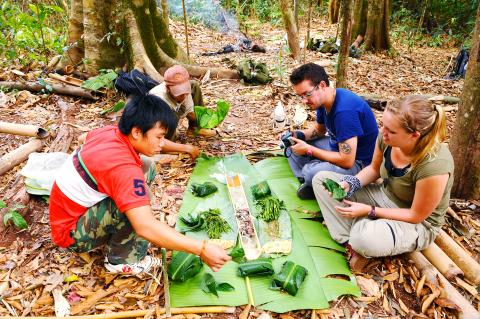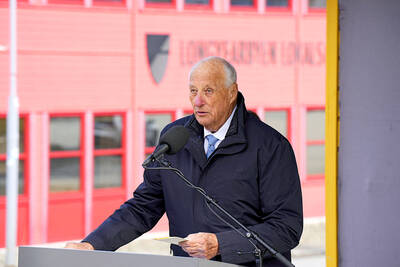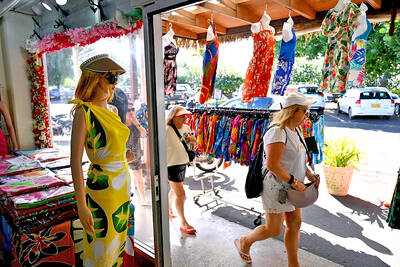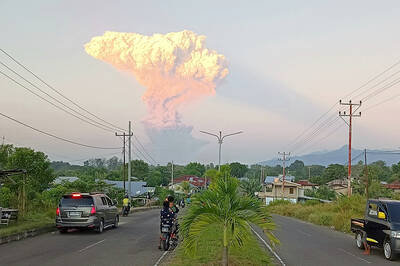In a hilltribe settlement in the forest of northern Laos, an old man sits on the ground weaving a basket while another villager hangs out her washing to dry.
It is a scene of everyday life for the Akha communities living in the Nam Ha Protected Area, where elephants, gibbons and leopards roam among giant bamboo near villages perched on the banks of a tributary of the Mekong River.
The 220,000-hectare national park is at the forefront of efforts by the landlocked, impoverished nation to become a leading eco-tourism destination — an effort that appears to be paying off.

Photo: AFP
Lured by the wild beauty and cultural riches of the numerous ethnic minorities, almost 250,000 tourists visited northwest Luang Namtha Province last year, up from 20,000 in 1999, according to the Laos tourism administration.
“Compared to Thailand it is definitely a lot more authentic, better run and the fact that we were just a small group, just four people, makes it a much more genuine experience,” 28-year-old British tourist Joe Park said.
“We perhaps leave less of a footprint and not too much of our own culture in the area, so I think it was fantastic,” he said during a trek inside the park.
While some ethnic villagers, such as the Lanten, still wear their indigo traditional clothes, they make no particular effort to dress up for tourists and go about their normal lives as much as possible when they come.
It is the fruit of years of planning by the Communist nation to attract more foreign visitors while preserving its cultural heritage.
After opening up to foreign visitors in the 1990s, Laos “quickly saw that being a country in the middle of the Mekong region, with many visitors going to the surrounding countries, that it would be a good opportunity to develop the economy and create local jobs,” said Steven Schipani, who was involved in the Nam Ha eco-tourism project as a UN advisor.
“But they were also aware that tourism, if not properly managed, can cause a lot of negative impacts,” added the American, who is now in charge of the Asian Development Bank’s Southeast Asia tourism program.
The Laotian authorities, who have created 20 national parks covering 14 percent of the country, attempted to manage the explosion in tourism to avoid lines of buses or rows of concrete hotels.
“Laos will become a world renowned destination specializing in forms of sustainable tourism that, through partnership and cooperation, benefits natural and cultural heritage conservation and local socio-economic development, and spreads knowledge of Laos’ unique cultural heritage around the world,” proclaims the state-run Web site www.ecotourismlaos.com.
The Nam Ha national park, thanks to a partnership with UNESCO dating back to 1999, has served as a model of development for eco-tourism aimed at benefiting local communities.
“Before, only backpackers, who often only rent a motorbike and drive around, not stopping in the villages, came to Namtha,” said Adrian Schuhbeck, a development expert with a German-backed agency in Luang Namtha Province. “But this is changing. People with more money come, which is good for the communities — they get more return.”
Thanks to the Nam Ha project, several dozen villages have signed agreements with local trekking agencies to supply guides, maintain the paths, share their traditional cuisine and offer a roof for the night, no more than twice a week.
For welcoming eight tourists — the maximum allowed in a -single group — on a two-day trek, a village receives about US$135, or more than a third of the ticket price, said Chittaphong Chanthakhoune, a local tour agent.
Hundreds of similar projects are being set up elsewhere in the sparsely populated country, one of the poorest in the world.
While it is not the answer to all the villages’ problems, Laos has at least avoided the pitfalls seen by its neighbors, where tour operators bring hordes of tourists to villages without consulting the locals.
Signs on the walls of local trekking agencies give advice to foreigners: Take off your shoes before entering a home, respect sites of worship and do not take photographs without asking the subject’s permission.
The villagers for their part have been educated about the needs of their visitors and ways to improve hygiene.
While it lures avid adventurers to its steep-sided valleys and villages lost in the middle of the forest, Laos has also equipped its capital, Vientiane, and the ancient city of Luang Prabang with a solid tourism infrastructure, capable of accommodating a rising number of visitors.
Tourist arrivals in the Communist nation have risen from scarcely 5,000 in 1991 to more than 2 million in 2009, according to official figures.
However, the eco-tourism boom “will only be sustainable if both sides understand what is important for each other,” Schuhbeck said.

BOMBARDMENT: Moscow sent more than 440 drones and 32 missiles, Volodymyr Zelenskiy said, in ‘one of the most terrifying strikes’ on the capital in recent months A nighttime Russian missile and drone bombardment of Ukraine killed at least 15 people and injured 116 while they slept in their homes, local officials said yesterday, with the main barrage centering on the capital, Kyiv. Kyiv City Military Administration head Tymur Tkachenko said 14 people were killed and 99 were injured as explosions echoed across the city for hours during the night. The bombardment demolished a nine-story residential building, destroying dozens of apartments. Emergency workers were at the scene to rescue people from under the rubble. Russia flung more than 440 drones and 32 missiles at Ukraine, Ukrainian President Volodymyr Zelenskiy

COMPETITION: The US and Russia make up about 90 percent of the world stockpile and are adding new versions, while China’s nuclear force is steadily rising, SIPRI said Most of the world’s nuclear-armed states continued to modernize their arsenals last year, setting the stage for a new nuclear arms race, the Stockholm International Peace Research Institute (SIPRI) said yesterday. Nuclear powers including the US and Russia — which account for about 90 percent of the world’s stockpile — had spent time last year “upgrading existing weapons and adding newer versions,” researchers said. Since the end of the Cold War, old warheads have generally been dismantled quicker than new ones have been deployed, resulting in a decrease in the overall number of warheads. However, SIPRI said that the trend was likely

‘SHORTSIGHTED’: Using aid as leverage is punitive, would not be regarded well among Pacific Island nations and would further open the door for China, an academic said New Zealand has suspended millions of dollars in budget funding to the Cook Islands, it said yesterday, as the relationship between the two constitutionally linked countries continues to deteriorate amid the island group’s deepening ties with China. A spokesperson for New Zealand Minister of Foreign Affairs Winston Peters said in a statement that New Zealand early this month decided to suspend payment of NZ$18.2 million (US$11 million) in core sector support funding for this year and next year as it “relies on a high trust bilateral relationship.” New Zealand and Australia have become increasingly cautious about China’s growing presence in the Pacific

Indonesia’s Mount Lewotobi Laki-Laki yesterday erupted again with giant ash and smoke plumes after forcing evacuations of villages and flight cancelations, including to and from the resort island of Bali. Several eruptions sent ash up to 5km into the sky on Tuesday evening to yesterday afternoon. An eruption on Tuesday afternoon sent thick, gray clouds 10km into the sky that expanded into a mushroom-shaped ash cloud visible as much as 150km kilometers away. The eruption alert was raised on Tuesday to the highest level and the danger zone where people are recommended to leave was expanded to 8km from the crater. Officers also